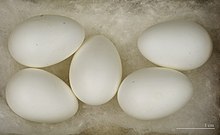Red swallow
| Red swallow | ||||||||||||
|---|---|---|---|---|---|---|---|---|---|---|---|---|

Red Swallow ( Cecropis daurica ) |
||||||||||||
| Systematics | ||||||||||||
|
||||||||||||
| Scientific name | ||||||||||||
| Cecropis daurica | ||||||||||||
| ( Linnaeus , 1771) |
The red swallow ( Cecropis daurica ) is a species from the swallow family.
description
The red swallow reaches a length of 16 to 18 centimeters. It has a reddish brown rump, a reddish brown neckband and a long tip of its tail. The underside is cream-colored without a dark spot on the neck. It flies more slowly than the barn swallow and appears to be in the air every now and then because it makes frequent use of updrafts.
It gives a characteristically rough, thin flight call. Your warning call is "kier". The singing is similar to that of the barn swallow, but less melodic.
The previous scientific name was Hirundo daurica . Recent scientific findings led to the name change to Cecropis daurica .
distribution and habitat
The distribution area of the red swallow extends from the Maghreb across the Iberian Peninsula along the northern edge of the Mediterranean Sea to Israel and northern Syria and Iraq. The distribution area extends over the south of Iran to India. The Indian and African red swallow are resident birds. The European and other Asian birds, on the other hand, are migratory birds. The European breeding birds overwinter in the south of the Sahara.
Until the 1950s, the red swallow was an extremely rare and irregular irregular visitor to Central Europe. Since the breeding area of this species has increased in southern Europe, it occurs almost every year as a stray visitor in Central Europe. Area expansions took place primarily on the Iberian Peninsula, where it has changed its breeding area half-fold since the 1950s. There are also breeding records for the south of France and the red swallow has been a regular breeding bird on Corsica since 1977. Red swallows have been breeding regularly in Romania since the 1970s. Their population has now grown to twenty to fifty breeding pairs.
In 1855, the first red ointment in Germany was found on Heligoland . Until 1970, only 10 red swallow swallows were observed in Germany. From 1970 to 2010, 82 recognized certificates were then provided. Most of the observations in Germany were made in the second half of April and the first half of May during the return home to southern Europe. It is believed that red swallows, which had reached Central Europe, mistakenly extended their migration north from Africa.
The red swallow is always close to the water. It builds its nest in houses, walls, caves and under bridges.
Reproduction
The nest is made of clay and saliva and is shaped like a bottle cut in half and hanging from the ceiling. The length of the "bottle neck" can be up to half a meter. The breeding season lasts 11 to 16 days between May and July. The nestling duration is 20–21 days.
food
The food consists of insects that are caught in the air.
literature
- Hans-Günther Bauer, Einhard Bezzel and Wolfgang Fiedler (eds.): The compendium of birds in Central Europe: Everything about biology, endangerment and protection. Volume 2: Passeriformes - passerine birds. Aula-Verlag Wiebelsheim, Wiesbaden 2005, ISBN 3-89104-648-0 .
Web links
- Age and gender characteristics (PDF; 2.0 MB) by Javier Blasco-Zumeta and Gerd-Michael Heinze (English)
- Feathers of the red swallow
- Hirundo daurica inthe IUCN 2013 Red List of Threatened Species . Listed by: BirdLife International, 2012. Retrieved October 12, 2013.


